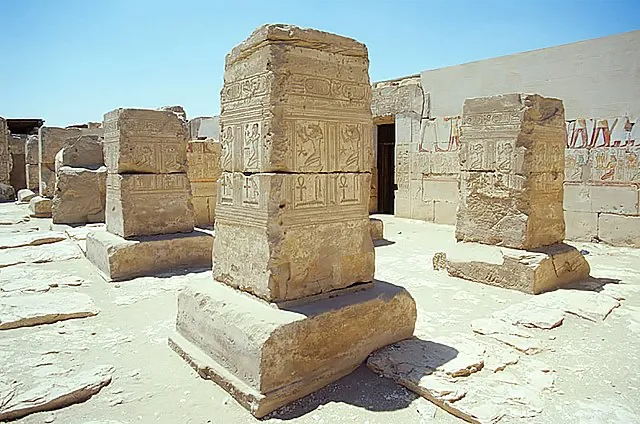The Temple of Ramses II at Abydos is a significant archaeological site in Egypt. It stands as a testament to the grandeur of ancient Egyptian civilization and the enduring legacy of one of its most powerful pharaohs, Ramses II. This temple, dedicated to the cult of Ramses II, is one of the many monuments that the pharaoh commissioned during his long reign. It is renowned for its intricate wall carvings and the historical insights it provides into ancient Egyptian religion and kingship.
Get your dose of History via Email
Historical Background of Temple of Ramses II Abydos
The Temple of Ramses II at Abydos was built by Ramses II, also known as Ramses the Great. He was one of the most prominent pharaohs of the New Kingdom period. The temple’s construction dates back to the 13th century BC. It served as a monument to Ramses II and was dedicated to the ancient Egyptian god Osiris. Abydos was a significant pilgrimage site, as it was associated with the afterlife and the cult of Osiris.
Flinders Petrie, a pioneering Egyptologist, first excavated the site in the late 19th century. His work laid the foundation for understanding the temple’s historical significance. The temple was part of Ramses II’s extensive building program, which aimed to immortalize his reign. Over time, the temple fell into disuse and was buried under the sands of Egypt until its rediscovery.
Later inhabitants and rulers did occupy the site. For instance, during the Coptic period, some parts of the temple were repurposed for Christian worship. This layering of history adds to the temple’s complexity and historical value.
The Temple of Ramses II at Abydos is not just a monument to a pharaoh’s ego. It also played a role in the political and religious life of ancient Egypt. The temple’s inscriptions and reliefs provide valuable information about the period’s diplomacy, warfare, and religious practices.
Significant events took place at the temple, including religious festivals and royal ceremonies. The temple’s location in Abydos, a site of great religious importance, further emphasizes its role in the cultural and spiritual life of ancient Egypt.
About Temple of Ramses II Abydos
The Temple of Ramses II at Abydos is an architectural marvel. It showcases the advanced construction techniques of ancient Egypt. The temple’s layout includes a pylon, courtyards, hypostyle halls, sanctuaries, and chapels. Each section has a specific function within the temple complex.
The temple’s walls are adorned with intricate bas-reliefs and hieroglyphs. These depict various scenes from the life of Ramses II, including his military victories and religious rituals. The quality of the artwork suggests that skilled artisans were involved in the temple’s decoration.
Limestone and sandstone were the primary materials used in the temple’s construction. These materials were common in ancient Egyptian architecture. The choice of materials reflects both the availability of resources and the desired aesthetic effect.
One of the architectural highlights of the temple is its seven chapels. These were dedicated to different deities and Ramses II himself. The chapels are a testament to the religious syncretism of the time, where the pharaoh was revered alongside traditional gods.
The temple’s construction methods and artistic achievements provide insight into the technological and cultural advancements of the New Kingdom period. The temple stands as a symbol of the period’s architectural prowess.
At a glance
Country: Egypt
Civilization: Ancient Egyptian
Age: Approximately 3,200 years old (13th century BC)
Conclusion and Sources
Reputable sources used in the creation of this article include:
- Wikipedia: https://en.wikipedia.org/wiki/Abydos,_Egypt

